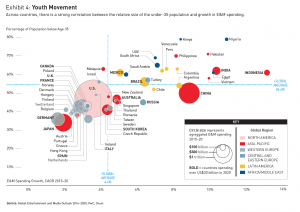This weekly reading talked about the shifts of entertainment and media companies in media industry which are growth and have so many opportunity in nowadays.It has 5 ways roiling the industry that can give us a definition of outlook in 2016-2020.Lederer and Brownlow believe that:"This global media landscape is multi-shifting."
To sum up these some exhibits they have illustrated, it can be concluded like points.
- E&M spending is growing more rapidly than GDP
- Different countries has different growth rates
- Revenue across E&M is steadily shifting from publishing businesses to video and Internet bussinesses
- Media industry still should target the youths
- Cultures and tastes in content remain steadfastly local
- Regional inconsis tency in regulation affects business models
- E&M companies that combine technology with industry-centric assets(relationships,customers and knowledge)
The most interest me is that in 2017 when China overtakes The U.S. in box office revenue, and China will held the leading position in an E&M segment which means China has the huge growth markets, and also China is well advanced in segments such as digital advertising.So that we konw that the business models could be the one of most important part. We should pay attention to the another noteworthy shift, because in many areas, the growth of technology and digitization acts as a powerful centrifugal force–breaking up existing relationships.
Lederer and Brownlow has concluded five shifts which really changes in the E&M landscape and provides more and more opportunities in media industry, it can also helps the companies plan and do business better.